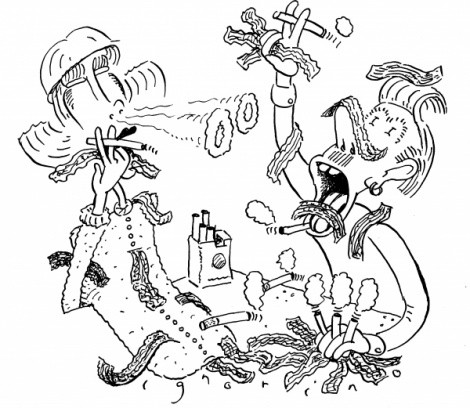
I need help putting to rest a rumor floating around the social networking world that bacon is just as dangerous to your health as cigarettes. Obviously nobody eats bacon at the rate of a pack a day like people do with cigarettes, because it's not addictive, but I bet it doesn't stop there. Please give me some ammunition!
—Jonathan
Yeah, it's not fair. Nobody’s claiming bacon is health food, but compared to smoking cigarettes, the Class X felony of bad habits, surely eating some fried pig fat is on a par with jaywalking. However, we don’t want feelings, we want facts. Much depends on individual consumption habits, so we’ll need an indication of relative risk—how many cigarettes = how many slices of bacon, death-threatwise. This doesn’t lend itself to precise analysis, and the following isn't something I'd care to defend before the Ph.D committee. But it'll do for the real world.
Let’s start with bacon. It contains, broadly speaking, four reputedly bad things: saturated fat, cholesterol, sodium and nitrites. Put away six strips a day and (assuming you’re an average American) you’ll find your dietary bad-thing quotient has increased as follows: saturated fat 2 percent, cholesterol 18 percent, sodium 30 percent, nitrites … well, nitrites involve some guesswork, but it looks like you’d see an increase of 100 to 300 percent in these carcinogens.
As best I can work it out, here’s the risk contributed by each:
- Saturated fat is tough to quantify risk for. Studies show little connection between raw fat intake and mortality risk in men. Women are in somewhat greater danger due to an apparent increased incidence of breast cancer, but no point figuring out exactly how much—a mere 2 percent increase in saturated fat consumption isn’t likely to have any noticeable effect.
- Cholesterol is more of a factor. The risk depends on how much the cholesterol in your diet increases your serum (blood) cholesterol. One government source claims a 300 percent increase in dietary cholesterol increases serum cholesterol by only 6 to 7 percent, which in turn increases the risk of coronary heart disease by 12 to 14 percent. Another study says decreasing dietary cholesterol by 200 milligrams per 1,000 kilocalories results in a 37 percent lower risk of death. If we turn that on its head—probably not an entirely kosher procedure, but I’m writing for the newspapers, not the National Institutes of Health—we project that a 200 mg/1,000 kcal increase in dietary cholesterol would result in a 37 percent increase in mortality risk. Don’t freak, though. Six slices of bacon per day increases the average American’s dietary cholesterol intake at most by 22 mg/1,000 kcal. Assuming a linear relationship, we calculate that six strips per day means a 4 percent increase in mortality due to cholesterol.
- Now, sodium. This one’s tricky. If you’re the high-risk type, sodium is not your friend—the NIH claims six additional grams of sodium in obese people increases the chance of cardiovascular-related death by 61 percent. However, the common view has been that, for the average U.S. adult, a little extra salt is harmless. In 2010, though, the New England Journal of Medicine published an analysis claiming a nationwide reduction in salt intake would save tens of thousands of lives yearly. If we buy the NEJM statistics and stick with the possibly questionable assumption that if less is good, more is bad, we estimate the sodium in six strips of bacon per day ups your death risk 3 percent.
- Finally, nitrites. According to government statistics, six slices per day increases colorectal cancer risk by 21 percent. Sounds bad, but that translates into just four additional deaths per 100,000 people annually, or an increased mortality risk of 0.004 percent, a negligible amount.
- So what’s our total risk? Ignoring saturated fat and nitrites and focusing on cholesterol and sodium, we get an increased death risk of a little under 7 percent from eating six strips of bacon per day.
- On to cigarettes. Here the risk has been more carefully worked out. A male smoker with a moderate habit (studying the numbers, I’d say we’re entitled to define this as a pack a day) increases his risk of death by 202 percent.
- To sum up, eating six strips of bacon per day increases your death risk around 7 percent, while smoking a pack a day increases it 202 percent. A little arithmetic tells us that:
- Risk of six strips of bacon = 3.4 percent of the risk of a pack of cigarettes.
- Risk of one strip of bacon = about 1/176th the risk of a pack of cigarettes per day. In other words, to equal the risk of smoking a pack a day, you’d have to stuff down 176 slices of bacon. Quite a few people do the former; nobody does the latter.
- To put it another way, one cigarette is roughly as dangerous as nine slices of bacon. Which, even bacon fanboys will concede, is about what you’d think.